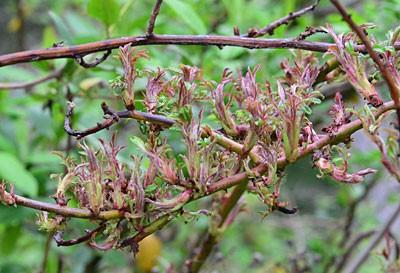Key points
- Rose rosette is becoming very apparent on wild roses along roadsides but has spread to home landscapes. This disease abbreviated (RRD), is caused by a virus and infects multiflora as well as ornamental roses, including KnockOut roses.
- The initial symptoms are reddening of the stems and stunted growth. Sometimes there is a proliferation or clustering of stems with excessive soft pliable thorns. The flowers may also abort. Infected roses may die within two years.
- The disease is transmitted by an eriophyid mite and by grafting. Mites can be carried by wind currents from infected roses to healthy plants downwind.
- Multiflora rose serves as the main source of infection in ornamental plantings.

Rose rosette symptoms. Photo: David L. Clement, University of Maryland
Management strategies
- Early detection is critical to prevent further disease spread within a planting.
- Infected roses should be uprooted and removed promptly. Since this disease is systemic and resides in the roots simple pruning will not cure diseased plants and will risk surrounding roses with infection.
- The remaining roses should be closely monitored for symptoms.
- If possible, multiflora roses should be removed from the vicinity as it is a disease carrier.
- Ornamental plantings should be planted upwind of multiflora roses and spaced so that their foliage will not touch.
- There are no pesticides for this disease and the control of eriophyid mites is very difficult.
Additional resource
(PDF) Early Detection of Rose Rosette Disease | The University of Tennessee
